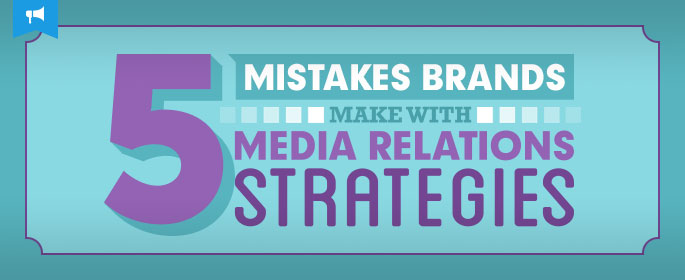
There are a number of articles giving advice on “how to get a placement in the Wall Street Journal in just three steps!” (or some variation of that). This is great for the small business owner or startup that can’t necessarily afford the services of a PR professional, but wants to take initiative and build brand awareness.
However, it’s not as simple as it seems.
Piecing together a multi-faceted media relations strategy takes work, time and preparation – even before you begin reaching out to reporters. It’s important to organize, think from a reporter’s point of view and be patient. To help guide you, we’ve outlined some of the key mistakes that brands make when planning and implementing their PR campaigns:
Not Preparing for Your PR Outreach Ahead of Time
There are a number of things to consider before starting a media relations strategy, including building a media list, determining who your spokespeople are, creating story angles, compiling fact sheets and more. Have everything you need – and everything a reporter might ask for.
How hard is it to have hi res images of your #hotel property ready? I shouldn’t have to chase you down to give you coverage. #PRFail #travel
— Karen Loftus (@LAKarenLoftus) February 10, 2015
20 emails and 18 hours later @TrendMicro can’t give me a single answer on a story they pitched me on #PRFail
— Sean Kerner (@TechJournalist) February 3, 2015
Most importantly, though, you want to define your goals for outreach. Are you trying to increase sales? Establish business partners? Get the community involved in an event? Knowing what you’re working toward will streamline all of the other aspects of your PR campaign.
Many times companies will simply begin outreach and not consider what they want to accomplish. To see the best results and be able to measure your success, you have to begin with the end in mind.
Being Too Self-Promotional
The most frustrating pitch a reporter can receive is one touting how great your service/brand/CEO/etc. is without some sort of timely and interesting story angle. You may believe that you have the best item on the market, but that’s not a story.
“Hi, I’m calling from so-and-so company. Do you want to speak to the CEO next week?”. That was the whole phone pitch. Er, no? #PRFail
— Anh Nguyen (@anhtbnguyen) February 5, 2015
To help, put yourself in the shoes of a newspaper reader. What would you find interesting about your company? Perhaps it’s that you’re using a new material that saves more energy than any before. Or, that you thought of the idea for your company while skydiving over New Zealand. There must be some sort of hook that reels the reader in. This is what will stand out to a reporter, because at the end of the day all they care about is what their audience will find informative, inspiring or entertaining.
Not Being Creative, Part 1: News Announcements
Many times clients have an idea of what their PR campaign should focus on – which is great and can make our jobs a little easier. They have a direction and a goal for the results of their plan. However, this can also make it a little more difficult when creating alternate story angles. As mentioned, when you’re reaching out to reporters you need to put yourself in the shoes of their readers. For example, when you’re pitching a story to Search Engine Watch, it will be a different angle than when discussing the story with Business Insider. The news will be the same, but you must be creative and tailor the announcement so that it pertains to whom you’re trying to reach. Search Engine Watch will want to know how the news will impact digital marketers, SEOs and PPC experts. Business Insider will be more interested in the financials, business partnerships and how it will influence entrepreneurs.
Not Being Creative, Part 2: There’s No News
Think about the last year of your business. How many major changes and updates have happened that could be used as a hard news announcement? If you’re like most organizations: probably just one or two – at most. This is the case for a number of companies, and that’s OK. But many times you’ll catch press releases being issued by companies that don’t contain any sort of news. Their thinking is that distributing this document is better than not being in the news at all.
When you are halfway through the press release and it says – “and here’s the point” – isn’t that a problem? #PRFAIL?
— Michelle Fay Cortez (@FayCortez) February 9, 2015
Don’t do this. Reserve your press release for real news.
Instead, think of story ideas focused on advice you can offer, profiles of executive team members, the founding story, timely news you can leverage, etc. These story angles will help to keep your company in the press. Just remember to not be self-promotional, and be sure your story angles are something that readers will find interesting.
Of course, you have to make sure your tie-ins to current events are extremely relevant and valuable to the current conversation – reporters will know when you’re just trying to promote yourself.
#PRfail: Starting your subject line with “Timely”. Rest assured, whatever follows is not timely or related to anything you do
— Ross Tucker (@RossTucker) February 11, 2015
Not Tracking the Results of Your PR Campaign
If you’re an SMB owner or a startup, you may not feel obligated to compile a report with the results of your PR plan. However, keeping track of the outcomes will aid you in a number of ways. For instance, if you plan to work with a PR agency in the future they will want a complete overview of the reporters you have relationships with (both negative and positive), the story angles you’ve pitched in the past, placements you’ve secured, the customers or web traffic these placements have delivered, and any other media interactions or consequences. This will not only help you prepare for future campaigns, but also avoid embarrassing situations.
Just pitched a story with a reporter, whom already wrote the story last year. From an identical pitch I sent him last year #PRFail
— Lee Jones (@lee_osp) February 4, 2015
In addition, this document will act as a great reference as you kick-off any other PR campaigns or if you’re working with a reporter but you can’t quite remember if you’ve worked with them before… Most importantly however, you want to know whether PR is impacting your business the way you want. Are you achieving the goals that you set out when you compiled your PR plan? If not, you can use this document to shift your strategy.
Giving Up When You Don’t Get Coverage Immediately
Even after putting together a plan, doing your research, tailoring the perfect pitch to the absolute right reporter… they can still say no.
Implementing a strategic PR plan is not a guarantee that your company is going to be covered by the press. You may receive a polite “No thank you,” or a simple “No.” The reporter may provide more helpful feedback, like “Please reach out to XYZ instead,” or “I just covered a similar story.” In extreme cases, you’ll receive some not-so-nice feedback, but most of the time your email will go unanswered.
Don’t lose hope. PR takes time and persistence. We work with a client who had placed 11 pieces of coverage in 2012. Since working with our team, however, in 2014 they received 27 direct requests from media members. Meaning that through the two years we worked together, when we were proactively reaching out to press, these reporters remembered our client and reached out to them for use as a reliable source. The on-going outreach strategy ended up securing this client 79 placements in 2014. Many of the journalists who posted stories were people we had pitched multiple times over the course of two years – so be patient with your PR plan.
Reading articles on how to create and implement a PR plan is the first step, but the research doesn’t stop there. Spend time really reading the articles that you want your company included in, the outlets that you want to target, and the social accounts of reporters that you want to email. This will give you an idea of the pitch angles and news announcements that they will be interested in. This knowledge and a persistent attitude will help to secure that coveted placement you’re working toward.





